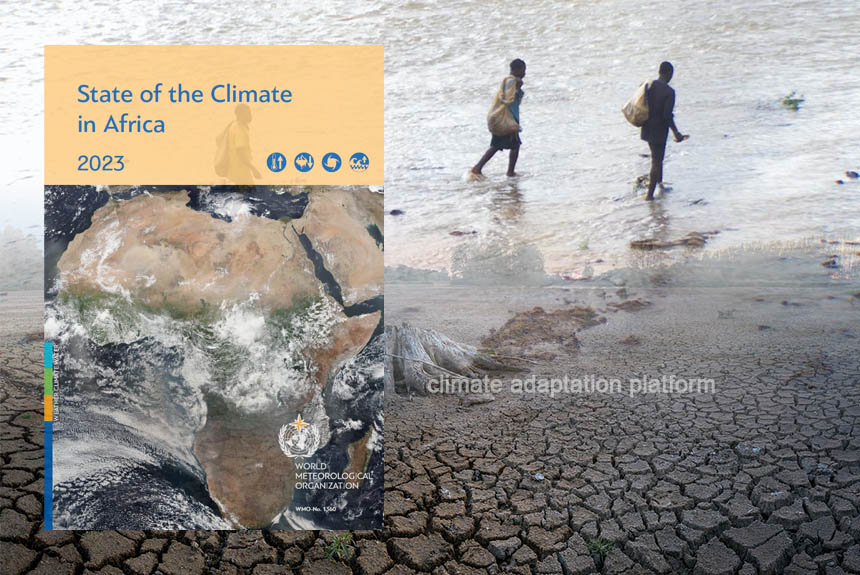Africa’s temperature increase is higher than the global average, making it highly vulnerable to climate change.
A new report from the World Meteorological Organization (WMO) shows that climate change impacts disproportionately burden Africa. Multi-year droughts and extreme floods are ravaging Africa’s economy.
Still, investment in climate change early warning systems will help mitigate risks, increase residence, and reduce the loss and damage to lives and livelihoods
The “WMO State of the Climate in Africa 2023” report report notes that African countries are losing 2 to 5% of their Gross Domestic Product. Many set aside 9% of their budget to respond to climate extremes. The cost of climate adaptation in sub-Saharan Africa is very high, estimated to be between US$ 30-50 billion annually over the next decade, representing 2-3% of their GDP.
Without adequate response measures, up to 118 million people will live in extinct poverty, living on less than US$ 1.90 per day by 2030, and will be exposed to drought, floods, and extremes.
Extreme droughts and precipitation hit various parts of Africa simultaneously
While many countries in the Horn of Africa, southern and North-West Africa continued to suffer exceptional multi-year drought in 2023 that persisted through 2024, eastern African countries, most recently in Sudan and South Sudan, experienced an exceptional seasonal rainfall that caused death and devastation.
Impacts of extreme climate events on the lives and food security in Africa
Extreme climate events such as floods and droughts have claimed many lives in Africa, significantly reducing food production and affecting food security. For instance, the flooding caused by Storm Daniel in September has killed 4700 in Libya, with 8000 still missing.
The April-June rainy season has caused widespread and severe flooding in parts of Kenya, Somalia and Ethiopia that claimed more than 350 deaths and displaced 2.4 million people. In September and October, approximately 300,000 people were affected by flooding across ten countries, with Niger, Benin, Ghana and Nigeria most heavily impacted.
Severe droughts in 2023 have severely impacted parts of Morocco, Algeria, Tunisia, Nigeria, Cameroon, Ethiopia, Madagascar, Angola, Zambia, Zimbabwe, and the Democratic Republic of Congo experienced. Zambia faced its worst drought in the last 40 years, affecting eight out of ten provinces and approximately six million people.
Droughts have reduced North Africa’s cereal production to 10% below the five-year average in 2023, and Tunisia was the worst hit. In Sudan, seasonal rains were below average and temporally erratic, with prolonged dry spells. The sorghum and millet production was forecast to decrease by about 25% and 50%, respectively, compared to 2022.
Calls to invest in early warning systems for Africa’s climate adaptation
“The State of Climate in Africa 2023 Report highlights the urgent need for investing in meteorological services and early warning systems to help adapt to climate change and build resilience in Africa. As the impacts of climate change continue to manifest globally, the African continent stands at a critical juncture,” said H.E. Ambassador Josefa Leonel Correia Sacko, Commissioner for Agriculture, Rural Development, Blue Economy and Sustainable Environment at the African Union Commission.
In September 2023, an ambitious “Early Warnings for All Action Plan” for Africa was launched during the Africa Climate Summit held in Nairobi, Kenya, in collaboration with various organisations, including the WMO, UNDRR, African Union, and International Federation of Red Cross.
The WMO news says, “The primary objective is to make sure that timely and accurate information about natural hazards and impending disasters reaches all segments of African society, particularly the most vulnerable. This answers the call of United Nations Secretary-General António Guterres that every person worldwide must be protected by early warning systems by 2027. A number of African countries have been identified as priorities for action in the global initiative.”
WMO Secretary-General Prof. Petteri Taalas highlights Africa’s high vulnerability to climate change, which is “undermining the socio-economic advancements achieved by the continent.”
“Between 1970 and 2021, Africa accounted for 35% of weather, climate, and water-related fatalities. Yet, only 40% of the African population has access to early warning systems – the lowest rate of any region worldwide. This new Early Warnings for All Action Plan for Africa seeks to change that,” said Prof. Taalas.
The document highlights that 2023 was the warmest year globally on record. The three major greenhouse gases (carbon dioxide, methane, and nitrous oxide) reached a new record in 2022. Ocean warming continues to increase, with the ocean heat content at a historic high in 2023.
As the ocean absorbs a quarter of annual human-caused emissions, increasing emissions also decrease pH, a process known as “ocean acidification.” Ocean acidification affects organisms and ecosystem services, including food security, by reducing biodiversity, degrading habitats, and endangering fisheries and aquaculture.
Africa stands at a critical crossroads in the fight against climate change. As temperatures rise faster than the global average, the continent faces a future where extreme droughts, floods, and food insecurity become the norm. But this future is not inevitable.
The 2023 State of the Climate in Africa report clearly shows that investing in early warning systems and climate adaptation could save millions of lives and secure the livelihoods of future generations. The cost of inaction is too high, threatening to push over 100 million people into extreme poverty.
Africa’s future depends on urgent, bold decisions made today, not just to mitigate climate disaster but to build resilience and ensure sustainable growth in the face of climate change.
Source:
Africa faces disproportionate burden from climate change and adaptation costs. (2024, September 2). World Meteorological Organization. Retrieved from https://wmo.int/news/media-centre/africa-faces-disproportionate-burden-from-climate-change-and-adaptation-costs
Early Warnings For All Action Plan for Africa is launched. (2023, September 4). World Meteorological Organization. Retrieved from https://wmo.int/media/news/early-warnings-all-action-plan-africa-launched
State of the Climate in Africa 2023. (2023). World Meteorological Organization. Retrieved from https://library.wmo.int/viewer/69000/download?file=1360_State-of-the-Climate-in-Africa-2023_en.pdf&type=pdf&navigator=1



Leave a Reply